|
PRO- Series
"DELUXE" Engine
OBDII CANBUS Code Reader
|
This reader supports all four OBD
II protocols:
*
SAE J1850 PWM
*
SAE J1850 VPW
*
ISO 9141-2
*
ISO 14230 (KWP2000)
*
CANBUS
WHAT IS CAN?
Controller Area Network (or
CAN) is the newest automotive communication protocol.
CAN Protocol is around 50 times the speed of the older
protocols.
CAN was used in some cars
starting in 2003, and is said to be the only protocol
that will be used after 2007. |
|
PRODUCT
FEATURES |
*
Works
with all 1996 and newer cars & trucks that are OBD II
compliant
*
Live
Data Stream
*
DTC
(Diagnostic Trouble Codes) meanings are displayed in
text mode
*
Reads
Freeze Frame Data
*
Large Backlit LCD Display
*
Large
Database of Diagnostic Trouble Code(s)
*
Clears
/ Turns off Check Engine Light
*
Reads VIN number: great for verification of used cars!
*
Tests I/M Status: Misfire Monitor, Fuel System, O2
System, EGR System, MIL Status
*
Reads and clears generic and manufacture specific
Diagnostic Trouble Codes (DTC)
*
Supports multiple trouble code requests: generic codes,
pending codes and manufacturer's specific codes
*
Highly
reliable and accurate
*
Easy
to read backlit LCD display
*
Easy
to use with one plug-in
*
Safely
communicates with the on-board computer
*
Stand-alone
unit with no need for an additional laptop computer to
operate
*
FULLY COMPATIBLE WITH CAN PROTOCOL
|





 |
|
|
| VEHICLE
COVERAGE: |
|
Does My Car Have
OBD-II?
All cars and light trucks built and sold in the United
States after January 1, 1996 were required to be OBD II
equipped. In general, this means all 1996 model year
cars and light trucks are compliant, even if built in
late 1995.
Two factors will show if your vehicle is definitely OBD
II equipped:
1) There will be an OBD II connector located under or
around the dashboard, and
2) There will be a note on a sticker or nameplate under
the hood: "OBD II compliant".
Where is the connector located?
The connector must be located within three feet of the
driver and must not require any tools to be revealed.
Look under the dash and behind ashtrays.

The Three Flavors of OBD II
While the parameters, or readings, required by OBD II
regulations are uniform, the auto manufacturers had some
latitude in the communications protocol they used to
transmit those readings to scanners. Naturally, each
felt they had the one true way, so we have three
different OBD II communications protocols in use.
What Communications Protocol
does my vehicle use?
As a rule of thumb, GM cars and light trucks use SAE
J1850 VPW (Variable Pulse Width Modulation). Chrysler
products and all European and most Asian imports use ISO
9141 circuitry. Fords use SAE J1850 PWM (Pulse Width
Modulation) communication patterns.
There are some variations among captive imports such as
the Cadillac Catera, a German Opel derivative, which
uses the European ISO 9141 protocol.
On 1996 and later vehicles, you
can tell which protocol is used by examining the OBD II
connector:
J1850 VPW--The connector should have metallic contacts
in pins 2, 4, 5, and 16, but not 10.
ISO 9141-2--The connector should have metallic contacts
in pins 4, 5, 7, 15, and 16.
J1850 PWM--The connector should have metallic contacts
in pins 2, 4, 5, 10, and 16.

|
|
COMPATIBILITY: |
Some compatible vehicles include:
Ford, Chevrolet, Chrysler, Acura, BMW, Buick, Cadillac,
Daewoo, Dodge, Fiat, GMC, Honda, Hyundai, Infinity,
Isuzu, Jaguar, Jeep, Kia, Land Rover, Lexus, Mazda,
Mercedes-Benz, Mercury, Mini, Mitsubishi, Nissan,
Oldsmobile, Peugeot, Pontiac, Porsche, Renault, Saab,
Saturn, Seat, Skoda, Smart, Suzuki, Toyota, Volkswagen,
Audi, Volvo, and many others.

(Note: may not be compatible with some VW, Audi, and
Subaru vehicles)
For a complete list of tested vehicles, click on the
link below. **Note: If your vehicle is not on this list
it does not mean that the scanner will not work for you.
This is only a list of tested vehicles.
|
|
SCANNER OPERATION
: |
*
Turn the ignition off
* Locate the 16-pin Data
Link Connector and plug the cable into the connector
* Wait for the LCD
Display
* Turn the ignition on
(needn't start the engine) and press enter
* The scanner will now
search for the specific protocol for your vehicle
* Follow On-Screen
Prompts and Menus!
|
|
SPECIFICATIONS/DIMENSIONS : |
*
7.76 x 3.16 x 1.27
* OBD Cable ~ 5' / 60"
* Display: 128 x 64
Backlit LCD Pixel Display
* Operating Temperature -
0 to 50 C
* Internal Power - 9v
Cell
* External Power: 10.0 to
15.5 volts provided via vehicle battery
* 16-pin OBD II Standard
Socket
|
|
